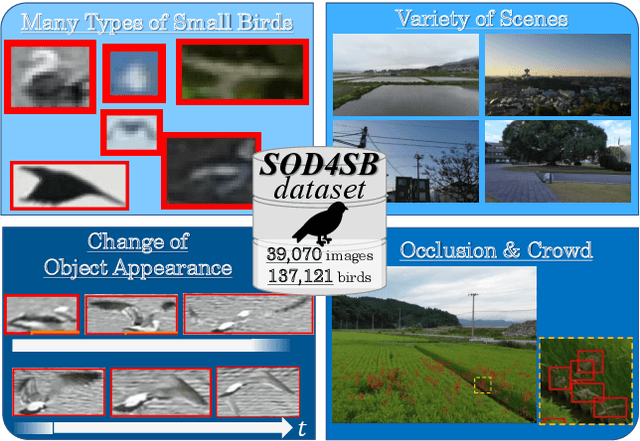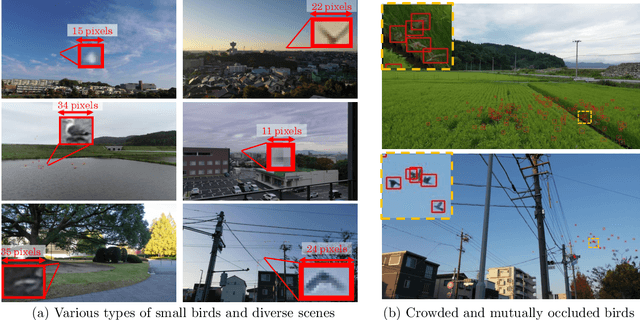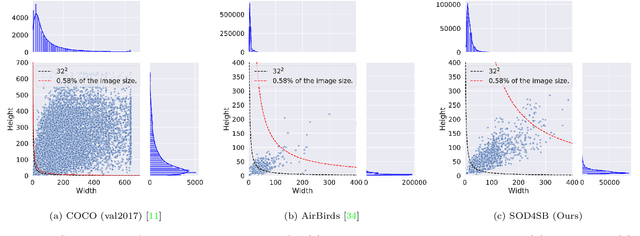Da Huo
Toward building next-generation Geocoding systems: a systematic review
Mar 24, 2025Abstract:Geocoding systems are widely used in both scientific research for spatial analysis and everyday life through location-based services. The quality of geocoded data significantly impacts subsequent processes and applications, underscoring the need for next-generation systems. In response to this demand, this review first examines the evolving requirements for geocoding inputs and outputs across various scenarios these systems must address. It then provides a detailed analysis of how to construct such systems by breaking them down into key functional components and reviewing a broad spectrum of existing approaches, from traditional rule-based methods to advanced techniques in information retrieval, natural language processing, and large language models. Finally, we identify opportunities to improve next-generation geocoding systems in light of recent technological advances.
MVA2023 Small Object Detection Challenge for Spotting Birds: Dataset, Methods, and Results
Jul 18, 2023



Abstract:Small Object Detection (SOD) is an important machine vision topic because (i) a variety of real-world applications require object detection for distant objects and (ii) SOD is a challenging task due to the noisy, blurred, and less-informative image appearances of small objects. This paper proposes a new SOD dataset consisting of 39,070 images including 137,121 bird instances, which is called the Small Object Detection for Spotting Birds (SOD4SB) dataset. The detail of the challenge with the SOD4SB dataset is introduced in this paper. In total, 223 participants joined this challenge. This paper briefly introduces the award-winning methods. The dataset, the baseline code, and the website for evaluation on the public testset are publicly available.
Neural Auction: End-to-End Learning of Auction Mechanisms for E-Commerce Advertising
Jun 07, 2021Abstract:In e-commerce advertising, it is crucial to jointly consider various performance metrics, e.g., user experience, advertiser utility, and platform revenue. Traditional auction mechanisms, such as GSP and VCG auctions, can be suboptimal due to their fixed allocation rules to optimize a single performance metric (e.g., revenue or social welfare). Recently, data-driven auctions, learned directly from auction outcomes to optimize multiple performance metrics, have attracted increasing research interests. However, the procedure of auction mechanisms involves various discrete calculation operations, making it challenging to be compatible with continuous optimization pipelines in machine learning. In this paper, we design \underline{D}eep \underline{N}eural \underline{A}uctions (DNAs) to enable end-to-end auction learning by proposing a differentiable model to relax the discrete sorting operation, a key component in auctions. We optimize the performance metrics by developing deep models to efficiently extract contexts from auctions, providing rich features for auction design. We further integrate the game theoretical conditions within the model design, to guarantee the stability of the auctions. DNAs have been successfully deployed in the e-commerce advertising system at Taobao. Experimental evaluation results on both large-scale data set as well as online A/B test demonstrated that DNAs significantly outperformed other mechanisms widely adopted in industry.
Interpreting Hierarchical Linguistic Interactions in DNNs
Jun 29, 2020



Abstract:This paper proposes a method to disentangle and quantify interactions among words that are encoded inside a DNN for natural language processing. We construct a tree to encode salient interactions extracted by the DNN. Six metrics are proposed to analyze properties of interactions between constituents in a sentence. The interaction is defined based on Shapley values of words, which are considered as an unbiased estimation of word contributions to the network prediction. Our method is used to quantify word interactions encoded inside the BERT, ELMo, LSTM, CNN, and Transformer networks. Experimental results have provided a new perspective to understand these DNNs, and have demonstrated the effectiveness of our method.
 Add to Chrome
Add to Chrome Add to Firefox
Add to Firefox Add to Edge
Add to Edge